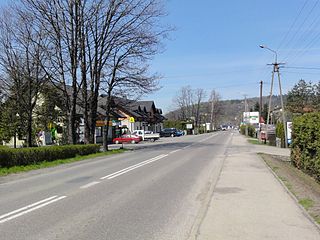
Strumień is a town and the seat of Gmina Strumień, in Cieszyn County, in the Silesian Voivodeship (province) of southern Poland, on the Vistula River.

is a village in and the seat of Gmina Brenna, Cieszyn County, Silesian Voivodeship, southern Poland, located in the historical region of Cieszyn Silesia. It is located in the Silesian Beskids mountain range, along the river Brennica, right tributary of the Vistula river.

is a village in Gmina Istebna, Cieszyn County in Silesian Voivodeship, southern Poland. The village is situated in Beskid Śląski mountain range, near to the borders with the Czech Republic and Slovakia, in the historical region of Cieszyn Silesia.

is a village and the seat of Gmina Chybie in Cieszyn County, Silesian Voivodeship, southern Poland. It lies in the Upper Vistula Valley within Oświęcim Basin and in the historical region of Cieszyn Silesia. There is a nature reserve called Rotuz in the eastern part of the village.

Brzezówka is a village in Gmina Hażlach, Cieszyn County, Silesian Voivodeship, southern Poland, near the border with the Czech Republic.

is a village in Gmina Brenna, Cieszyn County, Silesian Voivodeship, southern Poland. It lies in the historical region of Cieszyn Silesia.

Zbytków is a village in Gmina Strumień, Cieszyn County, Silesian Voivodeship, southern Poland. It has a population of 1,262. It lies in the historical region of Cieszyn Silesia.

Bąków is a village in Gmina Strumień, Cieszyn County, Silesian Voivodeship, southern Poland. It lies in the historical region of Cieszyn Silesia. Former village of Rychułd is now a western part of Bąków.

Zabłocie is a village in Gmina Strumień, Cieszyn County, Silesian Voivodeship, southern Poland. It has a population of 1,312 (2008) and an area of 19,03 km2. It lies in the historical region of Cieszyn Silesia.

Pierściec is a village in Gmina Skoczów, Cieszyn County, Silesian Voivodeship, southern Poland. It lies in the historical region of Cieszyn Silesia.

Kiczyce is a village in Gmina Skoczów, Cieszyn County, Silesian Voivodeship, southern Poland. It lies in the historical region of Cieszyn Silesia.

Kowale is a village in Gmina Skoczów, Cieszyn County, Silesian Voivodeship, southern Poland. It lies in the historical region of Cieszyn Silesia.

Wiślica is a village in Gmina Skoczów, Cieszyn County, Silesian Voivodeship, southern Poland.

Frelichów is a village in Gmina Chybie, Cieszyn County, Silesian Voivodeship, southern Poland. It lies in the historical region of Cieszyn Silesia.

Zarzecze is a village in Gmina Chybie, Cieszyn County, Silesian Voivodeship, southern Poland.

Landek is a village in Gmina Jasienica, Bielsko County, Silesian Voivodeship, southern Poland. Landek lies in the historical region of Cieszyn Silesia.

Wieszczęta is a village in Gmina Jasienica, Bielsko County, Silesian Voivodeship, southern Poland. It lies in the Silesian Foothills and in the historical region of Cieszyn Silesia.

Łazy is a village in Gmina Jasienica, Bielsko County, Silesian Voivodeship, southern Poland. It lies in the Silesian Foothills and in the historical region of Cieszyn Silesia.

Bronów is a village in Gmina Czechowice-Dziedzice, Bielsko County, Silesian Voivodeship, southern Poland. The village lies on the edge of the historical region of Cieszyn Silesia.

Lipowiec is a district (osiedle) of Ustroń, Silesian Voivodeship, Poland. It was a separate municipality, but became administratively a part of Ustroń on January 1, 1973.
























